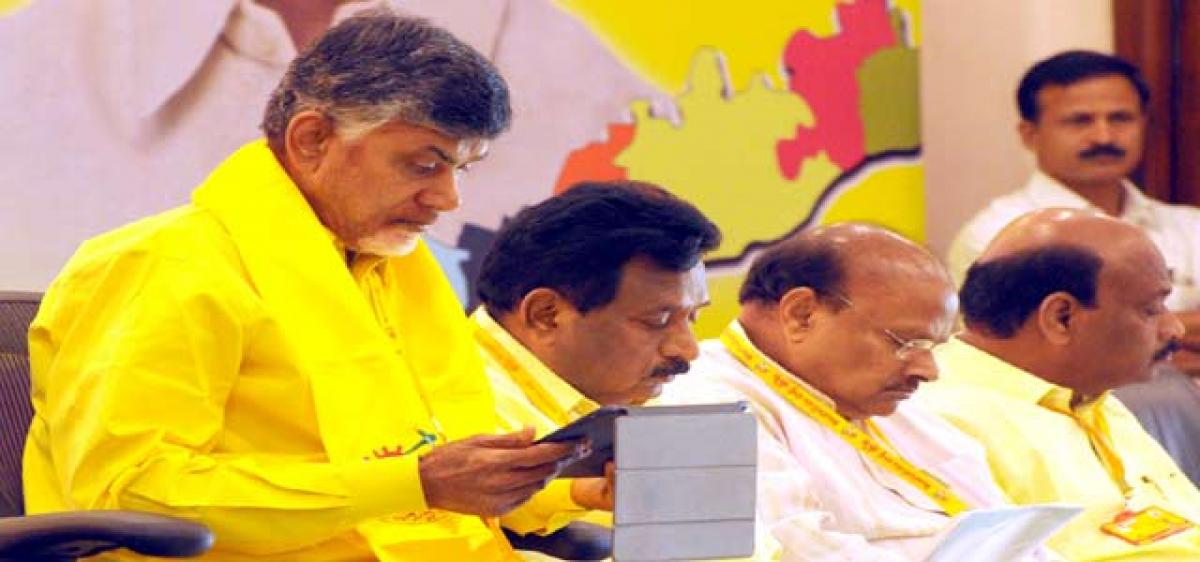Live
- Jagan treated cadres as ‘subordinates’, alleges Grandhi
- Mpower’s survey on edu loans
- IIP growth falls to 3.5% in Oct
- Easing food prices lower retail inflation to 5.48% in November
- Space allocation for packaging units at MSME parks on anvil
- Maha Kumbh: Yogi reviews preparations
- Gadkari on accidents: I try to hide my face in meetings abroad
- Abetment of suicide: Mere harassment not sufficient to find accused guilty says SC
- 6.79L homes to receive water under Amrut-II
- Cops prohibit assembly of 5 or more near Group-II exam centres
Just In

Andhra Pradesh Chief Minister and TDP president N Chandrababu Naidu could rightly notice the changing `colours’ in his party over a period of time. Delivering an inaugural address at his party meeting of MPs and MLAs a few days ago, he inadvertently spoke of dilution of the dress code in his party.
Andhra Pradesh Chief Minister and TDP president N Chandrababu Naidu could rightly notice the changing `colours’ in his party over a period of time. Delivering an inaugural address at his party meeting of MPs and MLAs a few days ago, he inadvertently spoke of dilution of the dress code in his party.
Delving into the `good old days’ of his mentor and party founder NT Rama Rao at the helm, Naidu recalled as to how the environs at the party meetings then looked bright yellow with the rank and file — from leader to ordinary worker – wearing yellow dress, the party symbol.
What seemed to be disturbing for Naidu was yellow “fading” into white, a reflection of influx of leaders from the other parties with divergent views.
Strikingly, more than 50 per cent of the leaders present at the meeting looked in milky white, drowning the party symbol of yellow.
For, the leaders like Rayapati Sambhasiva Rao (MP from Narsaraopet in Guntur district) and JC Diwakar Reddy (MP from Anantapur), who defected from either the Congress at the time of general elections in 2014 or from the YSRC after the elections, are not yet used to wearing yellow robes and they prefer to be seen in white.
Besides, there are some leaders like Municipal Administration Minister P Narayana, who remained as backroom boys until the General Elections and made it to the top after the party came to power.
Similarly, there are corporate honchos like Jayadev Galla, MP from Guntur, belonging to a different stream, who too managed to secure top positions in the government without adapting themselves to the party’s school of thought. The leaders of both the genres too seldom stick to the party dress code.
The Naidu’s talk of the changing colours, however, sent the party rank and file into nostalgia, mulling over the course of direction the party has taken ever since Naidu took over the reins from his mentor in an unsavory manner in the August coup in 1995 in terms of ideological and policy shifts.
Chandrababu also spoke of body language and the style of communication the leaders ought to adopt while interacting with the party workers and people, which also became a point of discussion in the party circles.
There was an established form of addressing NTR as “Anna garu” and it was followed by all — from leader to the worker and from rich to the poor till the end of his regime.
In fact, NTR too used to enjoy being called ‘Anna garu’ by everyone with a broad smile. Of course, the diction and dialect too changed in the party as a sequel to the change in leadership.
Evidently, the form of addressing Chandrababu Naidu changed into “Sir” after he succeeded NTR in the government and the party as well in suit with the corporate style and he himself liked to be called as the Chief Executive Officer.
Then he shifted his focus to the growing `indiscipline’ in the party during his speech and highlighted the need to equip the party with organisational discipline to face the upcoming elections.
The TDP was once known for internal discipline with no room for intra-party squabbles – that was how the party apparatus was strenuously built by Chandrababu as its general secretary.
Whatever happened to that trait which is the lifeline for any political party after the very architect of the party organisation became the helmsman?
“Our party was founded with an anti-Congress ideology as its bedrock and it only remained our strength for long.
When the party’s floodgates are open to the turncoats from the Congress and the YSRC, the fate of the party organisation started changing its course,” a party old-timer told this writer.
As if true to his observation, the party has become a divided house with warlords in almost all the districts, which witnessed defections from the Congress and the YSRC on a large-scale.
And, the constituencies where the MLAs crossed the fence are seeing a vertical split with the camps representing old timers and the defectors crossing the swords.
With the infiltration of the sitting MLAs from the YSRC, the hardcore loyalists aspiring for tickets in the next elections feel displaced.
Chandrababu is, however, trying to take both the rival groups within the party on board, holding the delimitation of Assembly constituencies as bait. “Money matters now in the party.
Opportunism and sycophancy have become the order of the day, and loyalty and honesty have no place whatsoever in the party under the present dispensation.
These maladies have to be addressed urgently so as to restore vitality and life into the party,” a senior leader commented on the changing form and character of the party.

© 2024 Hyderabad Media House Limited/The Hans India. All rights reserved. Powered by hocalwire.com







